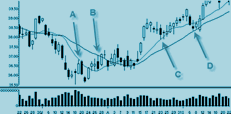IS TREND REALLY YOUR FRIEND?
By Toni Hansen
Is the trend really your friend? It is according to one of the most well-worn adages of technical analysis. But how many times have you bought a security off a support level in an uptrend, or shorted it off resistance in a downtrend, only to watch in disappointment as those support or resistance levels fail to hold, resulting in yet another stop? You tried to play nice with the trend, only to be snubbed! If the adage is true, then why do so many traders end up with a loss even though they traded in the direction of the prevailing trend?
The trend IS your friend, but like all friendships, it's a complicated one. Unless you understand the nature of a trend, your friendship is destined to fail. As any trader quickly realizes, there is a great deal more to trading successfully than merely identifying a security's trend and buying pullbacks in an uptrend or shorting bounces in a downtrend.
Let's begin with the basics: An uptrend is a series of higher highs and higher lows displayed on a price chart. A downtrend consists of lower lows and lower highs. A sideways trend is trading range in which the price of a security swings back and forth within a sideways trading channel. The three major trend types are shown in Figure 1. Conventional wisdom tells traders to buy in an uptrend, short in a downtrend, buy off the lower end of a sideways trend, and short off the upper end of a sideways trend.
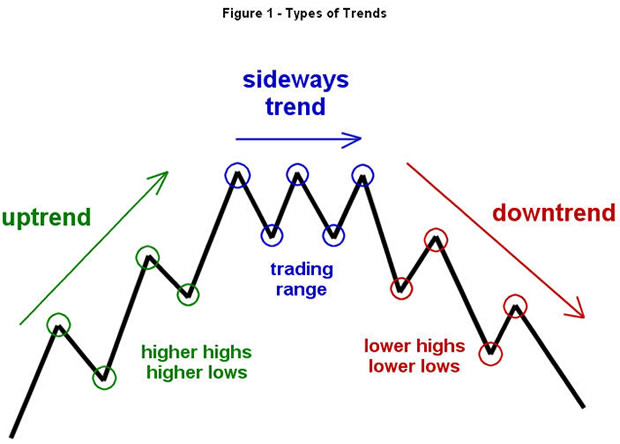
There are two major obstacles that you will run into when attempting to apply this traditional wisdom. First, not all trends are regular. In other words, while one type of support level may hold well in one uptrend, such as the popular 20 period moving average, in another trend it might hold the 10 period moving average on one pullback, then the 20 period the second time, then something somewhere in between as it advances higher. In each case, however, the security continues to make higher highs and higher lows, thus holding an uptrend. When different support level hold within the trend, it can be difficult to know which one to use as a guideline for initiating a long position.
You also have to keep in mind that no trend lasts forever. At some point an uptrend will become exhausted and will break through support instead of pulling back into it, bouncing, and then continuing higher once again. Without a solid understanding of how trends exhaust themselves and the tools for recognizing different types of exhaustion and how they affect the correction of a trend, you can easily find yourself on the wrong side of a market move.
A complete discussion of how trends form and in-depth strategies for timing different types of trends is outside the scope of this article and is discussed in great detail in the Trading Made Simple courses located at http://www.tonihansen.com/courses.html. There are a couple of powerful concepts, however, that you can quickly take and apply right away to improve your performance.
Most traders who pick up a book on technical analysis will run into the concept of trend formation or trend development whereby the trends consists of a series of three waves of upside that are often punctuated by two smaller corrective waves. Templates for this trend development are typically similar to the one shown below in Figure 2.
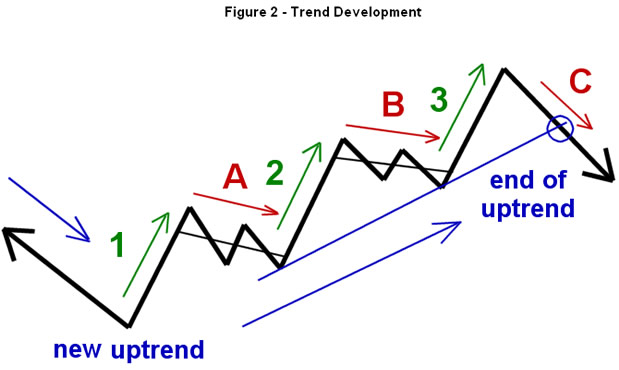
This template was created as a result of the long-term observation by a number of professional traders that trends themselves are predictable. One of the most notable forerunners of this theory was Ralph Nelson Elliott. The school of technical analysis known as Elliott Wave Principle, also called Elliott Wave Theory, bears his name. The basis of trend analysis is the belief that market price reflects the ebb and flow of human emotions and the activities that result from them. Going a step further, technical analysts such as myself, believe that human beings are creatures of habit, who, as a whole, are predictable, thus making price action in the markets also predictable to a very large degree.
Figure 2 of trend development depicts a trend in which there are three major waves of upside action. These waves are shown in green. In between each of the waves of upside is a corrective period. This corrective period is represented by a pullback that can have two to three waves of smaller downside moves before the larger uptrend resumes. In this example, one correction with a thin black line and a two-wave pullback with thick lines. The corrective periods, also known as pullbacks, are labeled A and B. If we believe that the trend is our friend, then we would want to buy these pullbacks in the uptrend.
For example, in Figure 3 there is an uptrend in play with a pullback at letter B. This would represent a strong buying opportunity. But what happened the next time the USD/JPY pulled back? The currency pair returned to the support from the uptrend channel at the 20 period moving average, labeled C. Instead of bouncing strongly off that support level as it had in the past, however, it broke cleanly through it after only pausing for a few minutes at the support level. This pause around noon would have been enough to convince some traders that the currency pair would react once again to this support level with a move to the upside. Very quickly, however, they would have realized the gravity of their mistake and been stopped out with a loss.
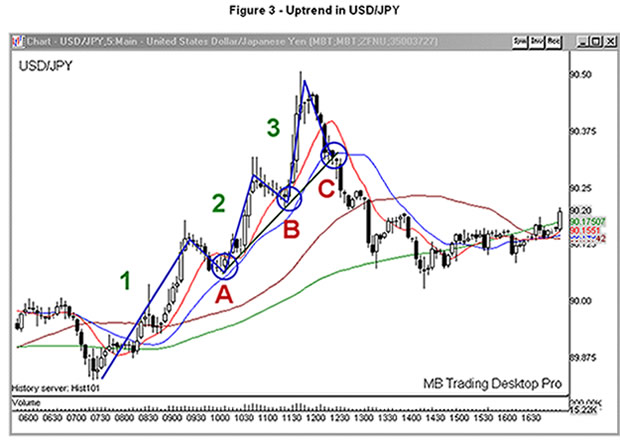
This takes us to one of the first key lessons of trend development: While it is ideal to trade in the direction of the trend in many cases, it is higher risk to take a position in the direction of an uptrend once the trend already has three waves of upside and vice versa for a downtrend. In Figures 2 and 3, the pullback off a third rally results in a break of the uptrend support.
Many traders stop here. The lessons learned up to this point are that the trend is your friend, but after the third wave of buying or selling, expect that trend to break. Trend development cannot be pinned down to a few catch-phrases, however. You must take your understanding of trend development another step further. While it is true that many trends will last for three waves and reverse, such as those in Figures 2 and 3, some trends will continue after a third wave of buying.
Over the years, I stumbled across this "three-wave" concept, but I also realized something else when studying my own trades. A very big difference in whether a trend lasted three waves or more was often a result of how long the correction periods lasted between each of the waves higher. When the amount of time it takes for A to form is roughly identical to B in Figure 2, then an attempt to correct that same amount of time at C to form another wave of buying will fall short. An attempt at a fourth wave higher simply does not produce the same results as in the previous three waves and stops become a lot more frequent.
So, the rule becomes amended yet again. For an uptrend: The trend is your friend in the first three waves of buying. If the correction periods are comparable between each wave of upside within that trend, however, a fourth wave of strong upside following a similar correction is unlikely and a larger correction will follow.
At times the trend will still continue, but it will need more time to rest before attempting such a move. For example, if you look carefully at Figure 3, you will notice that wave 1 actually has three smaller waves of buying within that first larger wave of upside shown on the chart. Then a longer correction forms that is marked A, before the uptrend resumes. In essence, there is a three wave trend formation on a smaller scale that forms within the first wave of upside on the larger scale.
Another example is shown in Figure 4 of the EUR/USD. On this chart there is a strong uptrend. It begins with three waves of upside that are punctuated by smaller, two-wave corrective moves such as in the trend template in Figure 2. The support zone for each correction is shown in dark green. The corrections between each of the initial three waves of upside lasted approximately the same amount of time before another wave of buying took place. When the EUR/USD pulled back for a third time at C, however, the uptrend did not immediately continue. In the previous example on Figure 3, the attempt to hold support at C failed completely after only a brief pause. In Figure 4, it makes the attempt to rally once again, but it falls short of a retest of the highs and leads to a second corrective move into the 100 period moving average shown in green. This larger correction breaks the uptrend briefly by creating a lower high and a lower low. Although the EUR/USD eventually continues higher, it was not able to do so until it first created a larger correction, thereby confirming the earlier rule: If the correction periods are comparable between each wave of upside within that trend, a fourth wave of strong upside following a similar correction is unlikely and a larger correction will follow.
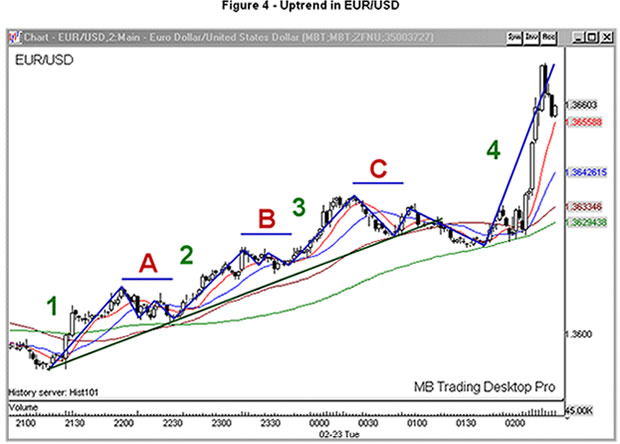
So, is the trend really your friend? Of course it is, but only if you take the time to get to know it well. The more you improve your understanding of how trends develop and the nature of trends themselves, the deeper your friendship will become, and hence the more rewarding as well!
Trend development is explored in depth in my 5 Technical Signals You Should Not Trade Without DVD course and textbook. This course is available online, as well as in hard-copy format. (All hard-copy order include online access.) To purchase this course, go to here
Testimonials for Toni Hansen
"Dear Toni, I want to thank you for sharing the knowledge and insights you have gained over the years as a professional trader. I would recommend your CD and mentoring to anyone serious about consistently making money in the market, regardless of market conditions. As an experienced investor who has watched you firsthand, it is clear that you are a world class trader. Thanks for helping me become a better trader." - Guy Allen, Florida
“I owe you so much when it comes to my development as a trader. You have been a guiding light... I will always look back on you as a key element in that success. Thank you so very much...” - Greg
“Anyone who is trading needs your guidance for the education of trading. Your education of trading aspects is the GREATEST thing I have ever used. I learned more in two weeks from you, than from any books I read. THANKS AGAIN!” - Clarence E. Austin
“I'm done for the day and am very pleased...I have taken all your calls and follow them to the T...the NQ ones that is (trade QQQQ) and I play the gaps in the morning also (I'll take the 71% chance anytime)...I have turned myself around...First time in months...Thank-you! ”- Richard Widen
“I hope that everyone truly understands just how fundamentally sound and accurate your market trading strategies and concepts are. I have been trading for quite some time, and I just want you to know that I have been so very impressed with your substance based upon sound trading fundamentals and not "fluff" THANK YOU...” - Randall Morrow

